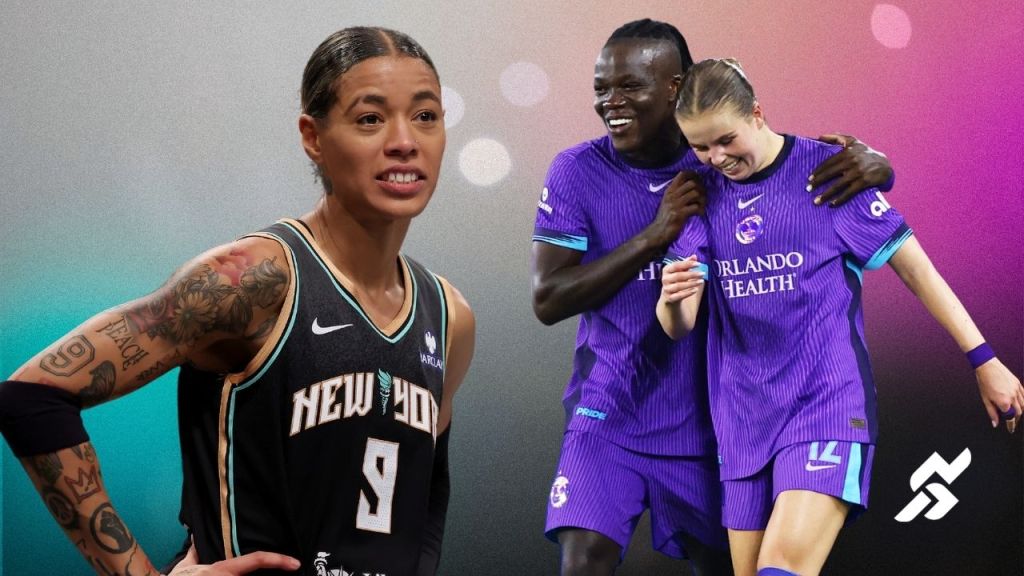NWSL's Groundbreaking CBA Paves the Way for WNBA Talks

The National Women’s Soccer League Players Association secured a historic collective bargaining agreement last August, which is widely viewed as a player-friendly blueprint for U.S. pro women sports leagues. The players nearly doubled the salary cap over the term of their CBA from $3.3 million this year to $5.1 million by the end of the deal in 2030. NWSL minimum salaries will also go from $48,500 this year up to $82,500 (plus bonuses) in six years, and there is no longer a limit on individual player salaries.
Now, the Women’s National Basketball Players Association is bargaining for a CBA that dramatically boosts the earnings potential of its members. The current WNBA CBA expires Oct. 31 after players exercised an opt-out, so, like NWSL players last year, WNBA veterans are navigating a season while negotiating with their league for a new agreement. While the WNBPA can use the NWSL's CBA for inspiration, there are differences in their leverage points and what they will pursue.
"The sports industry has been dominated for decades by the interests of men's sports," NWSLPA executive director Meghann Burke said at the time. "It's changing because of the players. We've seen it with the USWNT. We've seen it with the WNBA. And we are seeing it with the NWSL."
The WNBPA is prioritizing a revamped and equitable salary system in the wake of the significant business growth the league has experienced since the last CBA was signed in 2020. The WNBA's salary cap is currently $1.5 million, an amount the union is asking to more than double. Additionally, players are requesting an overhaul of the current revenue-sharing system, which pays players 50% of all incremental revenue, a percentage of earnings that exceed set growth targets.
Past CBAs have featured revenue-sharing targets that, if met, allow players to increase the cap; however those targets have proven elusive, even last year when there was a dramatic lift in ticket sales. WNBA players are also pushing for a greater portion of the league's revenue to be shared.
The NWSL’s base salary increases are spurred by a revenue-sharing mechanism (distributed from league revenue tied to the previous year's media rights and sponsorship dollars) that was included in the new agreement.
The NWSLPA's gains didn't stop at salary changes, and the WNBPA won't end there, either. The NWSL players pointed to the league draft as a competitive disadvantage-European soccer leagues don’t use one-and got it nixed during CBA negotiations last year. They also negotiated no-trade clauses for each player contracts, and all contracts are guaranteed, improving players’ security. Family planning services, childcare benefits and general health and wellness benefits have also been expanded. This is also an aspect of negotiations that WNBA players are hope to see improved as more athlete mothers compete.
Another element in WNBPA negotiations is the pressure the W faces from competing domestic leagues. WNBA players for years have opted to play abroad during the offseason, but the paradigm is shifting as more players decide to stay in the States with the advent of alternative leagues like Athletes Unlimited and Unrivaled. The increasingly high salaries offered in those upstart competitions, along with family-friendly benefits, give players leverage during CBA talks, as the W wants to ensure players prioritize its calendar.
Both leagues are still grappling with challenges, such as roster limits. The NWSL has a maximum of 26 spots; WNBA players aim to expand their 12-person per team limit. Los Angeles Sparks star Cameron Brink said last month on her podcast that she would rather see expanded rosters than additional teams via expansion. Salary cap restraints and limited roster spots have made it normal for drafted players to not make opening-day squads.
"[Having limited roster spots] doesn't create or foster development, which is another big issue within the league," WNBA agent Jade-Li English, who represents stars including A'ja Wilson and USC's JuJu Watkins, said in a phone interview.
The maximum number of NWSL games under the new CBA increased from 38 to 42. The league is expanding slowly with four mores games for each team this season (now 26 total), but that could change soon as two new teams (Boston and Denver) join next year. The WNBA, under the current CBA, expanded this season to an all-time high of 44 games with the Golden State Valkyries joining the league.
Phoenix Mercury star forward Satou Sabally voiced her displeasure with WNBA commissioner Cathy Engelbert for the slight uptick in games last weekend-adding another subject of contention in CBA talks.
"Cathy added a lot of games, and for us as players, recovery is so important," Sabally, who is on the WNBPA's CBA committee, told reporters. "We put our bodies on the line every single time, and we had nine games in 18 days. It's not really responsible for a commissioner."
- Union Needs Caitlin Clark in CBA Talks, Michael Jordan's Agent Says
Post a Comment for "NWSL's Groundbreaking CBA Paves the Way for WNBA Talks"
Post a Comment